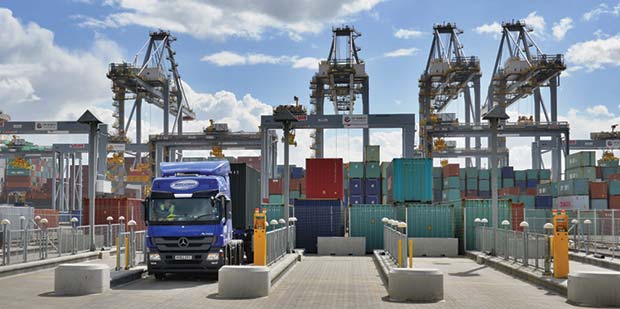After 10 years in gestation, DP World’s London Gateway (LG) container port officially opened on November 7th, costing £1.5 billion and promising 32,000 full-time jobs, not to mention substantial transport savings for road/rail container traffic. It will, however, do much more than that to enhance Britain’s logistics thanks in part to its 10 million ft2 logistics park, the largest in Europe, that will exploit its close proximity to London and the south-east, the largest and most prosperous part of its potential market.
 The park’s first tenant is Marks & Spencer, taking 1 million ft2 to build a £200 million distribution centre handling both imports and exports. Their plan is to deliver directly from ship to shop, a practice that, it was claimed, would cut distribution times from three weeks to three days, thus prolonging shelf life and sharply cutting stock-holding and handling costs.
The park’s first tenant is Marks & Spencer, taking 1 million ft2 to build a £200 million distribution centre handling both imports and exports. Their plan is to deliver directly from ship to shop, a practice that, it was claimed, would cut distribution times from three weeks to three days, thus prolonging shelf life and sharply cutting stock-holding and handling costs.
The logistics park, however, will not be for the exclusive use of large companies. A 300,000 ft2 common user facility, with shared handling equipment, should entice many SMEs and is reportedly 2-3 times oversubscribed. What will interest most prospective tenants and non users of the park, however, is how their logistics costs can be cut in relation to using other container terminals like Felixstowe, so how do these stack up? LG claims that a typical London round trip from its port will save £186. It will also eliminate the practice of sending some goods north to distribution points only to be sent back south again. The port’s new rail connexion is also expected to remove 100,000 TEU round trips annually from Britain’s roads as there will be four daily container train services from northern cities operated by DB Schenker and Freightliner, saving an estimated £58 per container trip. That will deliver marked environmental gains.
LG has its detractors, and not all from its competitors, from whom it must hope to take some business, despite the steady growth in container traffic from 7 million TEUs in 2005 to a projected 20 million TEUs a year by 2030. Undoubtedly there are risks with such a large venture but on closer scrutiny they seem overblown. One such risk is the new deep-sea container terminal planned for Liverpool, due to open in 2015, and another is the uncertainty in world trade growth, currently looking lethargic. A third threat could dwarf the first two – changing patterns in trade flows between Europe and Asia, a critical part of LG’s business model. For many reasons companies are re-shoring their outsourced manufacturing from the Far East back to Britain and Europe. While a trickle now, if it becomes a flood would it harm the port’s prospects? This journal posed that question to LG’s chief executive, Simon Moore, who agreed that trade patterns were changing but that it was a problem for shipping lines rather than ports.

Viewing the return of traditional manufacturing to Britain as a positive, he feels that if such companies grow again they will want to export to the growing consumer markets in Asia and the Continent. He also believes that 90% of Britain’s international trade will continue to move by sea, and some large UK retailers who currently import by air are thinking of switching to sea owing to LG’s strong business case. Still believing that most of that 90% will come from points east of the UK, he remains unfazed even if there were a trend towards more cargo between Britain and the Continent because LG’s location is a positive. “I think that we can’t inhibit, stop or encourage any particular market trend. We will hope to be flexible enough to have the physical capability to grow with them. So whether it’s more use by rail, we are ready for that. If it’s coastal shipping we are ready for that. It does not have to be big ships,” he said.

Big ships, however, are undeniably a strong selling point for LG, which when using all planned 6 berths will handle 3.5 million containers a year. The port will take the world’s largest, 18,000 TEU container ships at all states of the tide and is more weather proofed than container ports like Felixstowe where, it was claimed, it is typically closed for about 60 days a year owing to inclement weather. LG has another ace up its sleeve – full automation. Its ship-to-shore container handling cranes, the highest in the world, will be manned but from then on it will be fully automated, from driverless straddle carriers to storage gantry cranes. This will make operations not only slicker but safer, more secure and more cost effective.




Comments are closed.